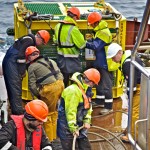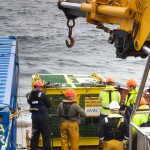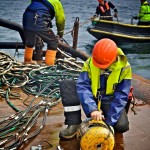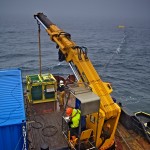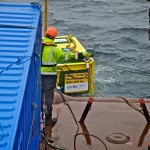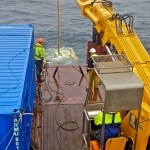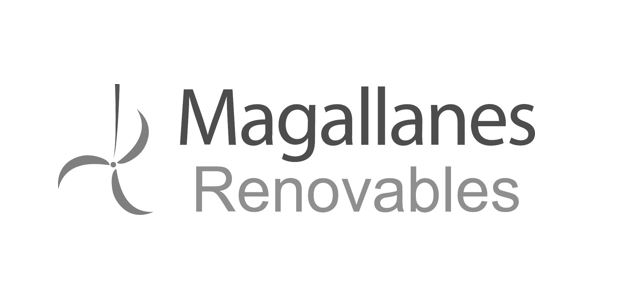Blog: Integrated data collection in hostile environments
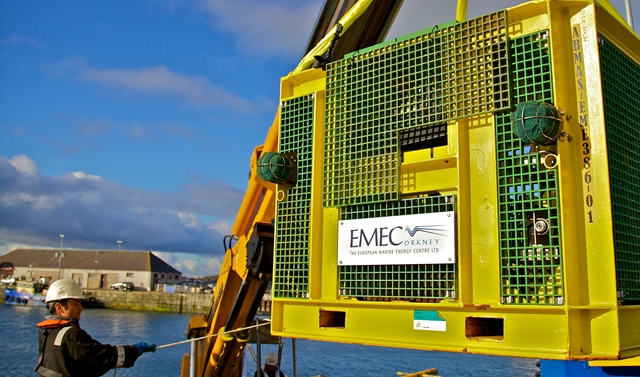
EMEC’s Integrated Monitoring Pod prior to being transported to the Fall of Warness tidal test site (Credit Colin Keldie)
Since its official opening in 2007, the EMEC tidal test site has been home to 14 tidal turbines – more than any other site in the world – being tested by six of the world’s most pioneering technology development companies in the tidal energy field.
Since the first ADCP (acoustic Doppler current profiler) drop in 2005, EMEC has overseen the deployment and recovery of 28 ADCP’s and has recorded over 460 days of tidal data.
For the last 10 years, we have continually monitored the wildlife around the site, local observers spending 20 hours a week (that’s around 1000 hours a year) meticulously noting siting’s of diving birds and cetaceans which use the site.
At EMEC’s Caldale substation, our weather station has provided real-time meteorological data since 2007, and our marine radar came online in 2011.
On top of this we have carried out numerous acoustic surveys at the site, and have tracked 1000’s of vessel movements over the years.
We have terabytes upon terabytes of data on our tidal test site, and yet, this is still “largely unchartered territory” according to our managing director, Neil Kermode.
And he’s right. With a peak tidal flow of 4 metres per second, or eight knots if you’re a mariner, half a billion tonnes of water passes through the Fall of Warness every hour at peak spring tides: imagine 100 million elephants an hour stampeding through a gorge only 2km wide for an idea of how challenging operations at the tidal test site can be.
Historically, mariners have avoided areas with such ferocious tidal flows, and now we’re trying to deploy machinery right in their midst to harness this immense energy.
Neil often reminds us of how huge our marine energy endeavour is: “This isn’t rocket science, it’s a lot harder. You fire a rocket into a vacuum, yet we’re trying to do things in salty, gritty, unforgiving seas, constantly in motion, home to hundreds of thousands of different species”.
And in order to make this work, we need to know as much as possible about the marine environment – the waves, the tides, the mammals that live in it – how it interacts with the tidal energy converters being deployed, and how those converters interact with the environment.
Understanding this environment is crucial, but gathering data within this resource is no mean feat, and despite the vast amount of data that has been collected and analysed so far, we really have only just begun to scratch the surface.
Enter EMEC’s Integrated Monitoring Pod – the world’s first cabled system enabling simultaneous real-time data flows from a variety of sensors within high energy marine environments.
The target date for deployment – 26 June 2015 – chosen due to good quality predicted slacks during relatively long neaps, teamed with vessel availability, and a good forecast for both sea and weather conditions.
The operation began smoothly as an innovative mooring array was installed by Leask Marine, the midsummer light enabling work to continue into the evening. The subsea cable, which powers the Pod and enables real-time data feeds back to shore, was hoisted to deck, ready for J+S Ltd to test. The Pod was energised on deck during the late evening of 25 June and initial tests of the system conducted. Commissioning tests were undertaken from the Stromness operations room during the early morning of 26 June to establish viable communications with routers, data switches and sensors.
The weather and sea conditions were outside of safe operating limits for an early deployment so the Pod was rigged up for deployment in the afternoon slack period. The weather was good, the Pod deployed safely onto the target foundation, re-energised and basic communications re-established. Drop cameras on the subsea rigging allowed a perfect view of the pod deployment and facilitated accurate location control by the vessel skipper and the offshore installation manager. Initial communications tests were repeated on network termination equipment and sensors, all found to be responding as expected. The early stages of sensor commissioning were then undertaken with front-end data acquisition applications being invoked and raw data taken and recorded from each sensor to prove good responses and realistic data acquired.
The success of the deployment marked a major achievement to the EMEC team and supply chain involved, and was the outcome of months of meticulous planning.
“It was an incredibly exciting moment when we saw the first live data feeds coming through from the Pod” said Neil.
Deployment opportunities in tidal straits arise for only a few days twice monthly during neap periods when tidal flow is slower and slack periods are longer thus enabling safe workboat activities on the high energy tidal site. Even during slack, when it appears calm on the surface, tides can flow in different directions at different depths even within one water column.
With minimal resources available at sea, you have to plan for the unexpected ensuring you have everything you need – as well as everything you might need, and hopefully won’t need – on board. Thorough minute-by-minute planning is essential in order to take advantage of an entire slack water period. Many hours were spent going through various scenarios: time well spent as the whole operation was conducted according to plan.
The planning continued throughout the operation, with continual dialogue between the vessel master, offshore installation manager and EMEC operations director monitoring the progress of operations, moorings, weather, and tide, updating plans and factoring in contingencies should the need occur to abandon operations.
“Credit goes to the team here at EMEC as well as Leask Marine, Bryan J Rendall (Electrical), RM Computing, Numerical Business and J&S” adds Mr Kermode.
“The Pod was deployed in a highly volatile tidal environment, and we’re glad to have such a competent local supply chain with the combined experience, ingenuity and seamanship to make a tricky project like this run relatively smoothly. Having worked with these companies on many projects throughout the years makes the job a lot easier to manage.”
The entire operation was conducted without a dynamic positioning (DP) vessel, the mooring solution providing sufficient control to accurately deploy the pod and cable. As well as being significantly cheaper than DP vessels, locally available vessels have a significantly lower carbon footprint.
The majority of purchases were made within Scotland, with the main suppliers based in Orkney. However, some specialist parts had to be procured from further afield. Given that this was a single prototype development, these were relatively small orders for our suppliers, and therefore not given high priority resulting in longer lead times than expected.
First stage re-assembly was completed by J+S who conducted a thorough infrastructure cabling upgrade on the Pod prior to it being transported back to Orkney. Final assembly work was then conducted by EMEC staff, including the installation of additional sensors, refurbished sensors, new power and communications wiring harnesses, power conditioning equipment, new data network routing and switching equipment, and systems’ health monitoring facilities.
The individual elements were unit tested, the Pod then system tested with each subsystem sealed and pressure tested in readiness for deployment subsea. By breaking down the commissioning process into small, clear, granular steps, small setup or connectivity issues were revealed at an early stage before diagnosis became complicated by the wider system.
The Pod can deliver live data feeds back to EMEC and the marine energy developers using the site, with raw data going through our quality control system.
The Pod has been set up as a plug-and-play prototype with the ability to install additional sensors as required, with future development focused on supporting data collection at commercial marine energy array projects.
Lessons learnt from the design, development and deployment of the Pod are being discussed and planned into future operational deployments of equipment at EMEC.
Key lessons learnt:
Detailed and dynamic planning is imperative
Never underestimate the hostility of the offshore tidal environment:
- Thorough planning for all eventualities pays off when operating in tidal conditions, with sensitivity for unexpected weather changes required.
- Combined skill of supply chain is paramount to the success of operations at sea.
- Cables need to be routed and protected in an over-engineered way to eliminate the potential for movement and exposure to debris.
- When deploying kit at relatively shallow depths in a turbulent and reasonably oxygen rich environment, electrochemical reactions between dissimilar materials can occur causing accelerated corrosion and weakness.
Good communications and collaboration throughout the supply chain is vital:
- Long-term relationships and familiarity with all personnel involved can be fundamental to the success of a project at sea.
Operations can be completed in high velocity tidal conditions without the use of a dynamic position vessel:
- With the right planning and collaboration, the local supply chain has the experience and knowledge to pull it off.
Procurement:
- If there is a need for specialist, bespoke parts to be created, the priorities of large suppliers should be factored in as this may affect lead times.
Bite-sized chunks approach:
- Breaking the commissioning into small manageable steps can ensure little issues do not become big issues later down the line.
If you would like to learn more about EMEC’s Integrated Monitoring Pod and how to get involved in its development, please contact: info@emec.org.uk.
